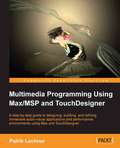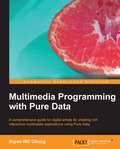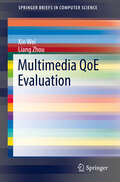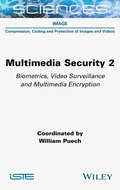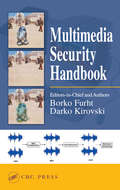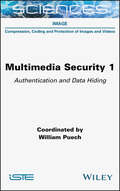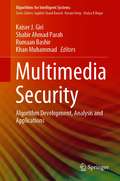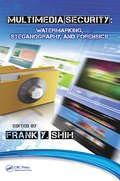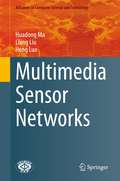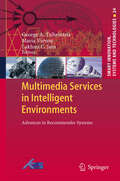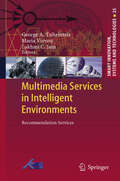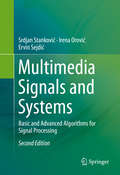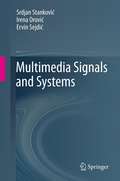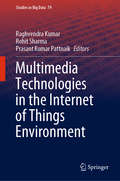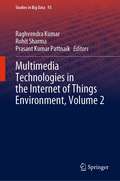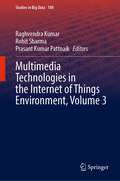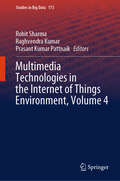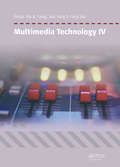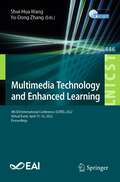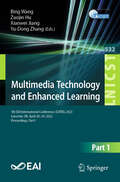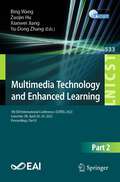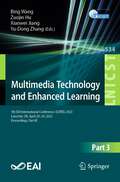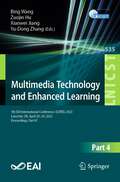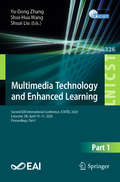- Table View
- List View
Multimedia Programming Using Max/MSP and TouchDesigner
by Patrik LechnerIf you want to learn how to use Max 6 and/or TouchDesigner, or work in audio-visual real-time processing, this is the book for you. It is intended for intermediate users of both programs and can be helpful for artists, designers, musicians, VJs, and researchers. A basic understanding of audio principles is advantageous.
Multimedia Programming with Pure Data
by Bryan Wc ChungA quick and comprehensive tutorial book for media designers to jump-start interactive multimedia production with computer graphics, digital audio, digital video, and interactivity, using the Pure Data graphical programming environment.An introductory book on multimedia programming for media artists/designers who like to work on interactivity in their projects, digital art/design students who like to learn the first multimedia programming technique, and audio-visual performers who like to customize their performance sets
Multimedia QoE Evaluation (SpringerBriefs in Computer Science)
by Liang Zhou Xin WeiThis SpringerBrief discusses the most recent research in the field of multimedia QoE evaluation, with a focus on how to evaluate subjective multimedia QoE problems from objective techniques. Specifically, this SpringerBrief starts from a comprehensive overview of multimedia QoE definition, its influencing factors, traditional modeling and prediction methods. Subsequently, the authors introduce the procedure of multimedia service data collection, preprocessing and feature extractions. Then, describe several proposed multimedia QoE modeling and prediction techniques in details. Finally, the authors illustrate how to implement and demonstrate multimedia QoE evaluation in the big data platform. This SpringerBrief provides readers with a clear picture on how to make full use of multimedia service data to realize multimedia QoE evaluation. With the exponential growth of the Internet technologies, multimedia services become immensely popular. Users can enjoy multimedia services from operators or content providers by TV, computers and mobile devices. User experience is important for network operators and multimedia content providers. Traditional QoS (quality of service) can not entirely and accurately describe user experience. It is natural to research the quality of multimedia service from the users’ perspective, defined as multimedia quality of experience (QoE). However, multimedia QoE evaluation is difficult, because user experience is abstract and subjective, hard to quantify and measure. Moreover, the explosion of multimedia service and emergence of big data, all call for a new and better understanding of multimedia QoE.This SpringerBrief targets advanced-level students, professors and researchers studying and working in the fields of multimedia communications and information processing. Professionals, industry managers, and government research employees working in these same fields will also benefit from this SpringerBrief.
Multimedia Security 2: Biometrics, Video Surveillance and Multimedia Encryption
by William PuechToday, more than 80% of the data transmitted over networks and archived on our computers, tablets, cell phones or clouds is multimedia data – images, videos, audio, 3D data. The applications of this data range from video games to healthcare, and include computer-aided design, video surveillance and biometrics. It is becoming increasingly urgent to secure this data, not only during transmission and archiving, but also during its retrieval and use. Indeed, in today&’s "all-digital" world, it is becoming ever-easier to copy data, view it unrightfully, steal it or falsify it. Multimedia Security 2 analyzes issues relating to biometrics, protection, integrity and encryption of multimedia data. It also covers aspects such as crypto-compression of images and videos, homomorphic encryption, data hiding in the encrypted domain and secret sharing.
Multimedia Security Handbook
by Borko Furht Darko KirovskiIntellectual property owners who exploit new ways of reproducing, distributing, and marketing their creations digitally must also protect them from piracy. Multimedia Security Handbook addresses multiple issues related to the protection of digital media, including audio, image, and video content. This volume examines leading-edge multimedia securit
Multimedia Security, Volume 1: Authentication and Data Hiding
by William PuechToday, more than 80% of the data transmitted over networks and archived on our computers, tablets, cell phones or clouds is multimedia data - images, videos, audio, 3D data. The applications of this data range from video games to healthcare, and include computer-aided design, video surveillance and biometrics.It is becoming increasingly urgent to secure this data, not only during transmission and archiving, but also during its retrieval and use. Indeed, in today’s "all-digital" world, it is becoming ever-easier to copy data, view it unrightfully, steal it or falsify it.Multimedia Security 1 analyzes the issues of the authentication of multimedia data, code and the embedding of hidden data, both from the point of view of defense and attack. Regarding the embedding of hidden data, it also covers invisibility, color, tracing and 3D data, as well as the detection of hidden messages in an image by steganalysis.
Multimedia Security: Algorithm Development, Analysis and Applications (Algorithms for Intelligent Systems)
by Kaiser J. Giri Shabir Ahmad Parah Rumaan Bashir Khan MuhammadThis book is a collection of outstanding content written by experts working in the field of multimedia security. It provides an insight about various techniques used in multimedia security and identifies its progress in both technological and algorithmic perspectives. In the contemporary world, digitization offers an effective mechanism to process, preserve and transfer all types of information. The incredible progresses in computing and communication technologies augmented by economic feasibility have revolutionized the world. The availability of efficient algorithms together with inexpensive digital recording and storage peripherals have created a multimedia era bringing conveniences to people in sharing the digital data that includes images, audio and video. The ever-increasing pace, at which the multimedia and communication technology is growing, has also made it possible to combine, replicate and distribute the content faster and easier, thereby empowering mankind by having a wealth of information at their disposal. However, security of multimedia is giving tough time to the research community around the globe, due to ever-increasing and efficient attacks carried out on multimedia data by intruders, eves-droppers and hackers. Further, duplication, unauthorized use and mal-distribution of digital content have become a serious challenge as it leads to copyright violation and is considered to be the principal reason that refrains the information providers in freely sharing their proprietary digital content. The book is useful for students, researchers and professionals to advance their study.
Multimedia Security: Watermarking, Steganography, and Forensics
by Frank Y. ShihMultimedia Security: Watermarking, Steganography, and Forensics outlines essential principles, technical information, and expert insights on multimedia security technology used to prove that content is authentic and has not been altered. Illustrating the need for improved content security as the Internet and digital multimedia applications rapidly evolve, this book presents a wealth of everyday protection application examples in fields including multimedia mining and classification, digital watermarking, steganography, and digital forensics. Giving readers an in-depth overview of different aspects of information security mechanisms and methods, this resource also serves as an instructional tool on how to use the fundamental theoretical framework required for the development of extensive advanced techniques. The presentation of several robust algorithms illustrates this framework, helping readers to quickly master and apply fundamental principles. Presented case studies cover: The execution (and feasibility) of techniques used to discover hidden knowledge by applying multimedia duplicate mining methods to large multimedia content Different types of image steganographic schemes based on vector quantization Techniques used to detect changes in human motion behavior and to classify different types of small-group motion behavior Useful for students, researchers, and professionals, this book consists of a variety of technical tutorials that offer an abundance of graphs and examples to powerfully convey the principles of multimedia security and steganography. Imparting the extensive experience of the contributors, this approach simplifies problems, helping readers more easily understand even the most complicated theories. It also enables them to uncover novel concepts involved in the implementation of algorithms, which can lead to the discovery of new problems and new means of solving them.
Multimedia Sensor Networks (Advances in Computer Science and Technology)
by Liang Liu Hong Luo Huadong MaSensor networks are an essential component of the Internet of Things (IoT), and Multimedia Sensor Networks (MSNs) are the most important emerging area in sensor networks. However, multimedia sensing is characterized by diversified modes, large volumes of data, considerable heterogeneity, and complex computing, as a result of which the theory and methods for traditional sensor networks can’t be applied to MSNs. Based on the authors’ years of systematic research on related theory and methods, this book provides a comprehensive review of MSNs. The coverage ranges from networked sensing and fusion-based transmission, to route discovery and in-network computing. The book presents the most important scientific discoveries and fundamental theories on MSNs, while also exploring practical approaches and typical applications. Given its scope, it is especially suitable for students, researchers and practitioners interested in understanding scientific problems involved in characterizing multimedia sensing features, revealing the transmission mechanisms of MSNs, and constructing efficient in-network multimedia computing paradigms. In this book, readers will learn essential methods for achieving the optimal deployment of, efficient and reliable transmission, and timely information processing in MSNs.
Multimedia Services in Intelligent Environments: 24
by Lakhmi C. Jain Maria Virvou George A. TsihrintzisMultimedia services are now commonly used in various activities in the daily lives of humans. Related application areas include services that allow access to large depositories of information, digital libraries, e-learning and e-education, e-government and e-governance, e-commerce and e-auctions, e-entertainment, e-health and e-medicine, and e-legal services, as well as their mobile counterparts (i.e., m-services). Despite the tremendous growth of multimedia services over the recent years, there is an increasing demand for their further development. This demand is driven by the ever-increasing desire of society for easy accessibility to information in friendly, personalized and adaptive environments. In this book at hand, we examine recent Advances in Recommender Systems. Recommender systems are crucial in multimedia services, as they aim at protecting the service users from information overload. The book includes nine chapters, which present various recent research results in recommender systems. This research book is directed to professors, researchers, application engineers and students of all disciplines who are interested in learning more about recommender systems, advancing the corresponding state of the art and developing recommender systems for specific applications.
Multimedia Services in Intelligent Environments: 25
by Lakhmi C. Jain Maria Virvou George A. TsihrintzisMultimedia services are now commonly used in various activities in the daily lives of humans. Related application areas include services that allow access to large depositories of information, digital libraries, e-learning and e-education, e-government and e-governance, e-commerce and e-auctions, e-entertainment, e-health and e-medicine, and e-legal services, as well as their mobile counterparts (i.e., m-services). Despite the tremendous growth of multimedia services over the recent years, there is an increasing demand for their further development. This demand is driven by the ever-increasing desire of society for easy accessibility to information in friendly, personalized and adaptive environments. In this book at hand, we examine recent Advances in Recommender Systems. Recommender systems are crucial in multimedia services, as they aim at protecting the service users from information overload. The book includes nine chapters, which present various recent research results in recommender systems. This research book is directed to professors, researchers, application engineers and students of all disciplines who are interested in learning more about recommender systems, advancing the corresponding state of the art and developing recommender systems for specific applications.
Multimedia Services in Intelligent Environments: Advances in Recommender Systems
by Lakhmi C. Jain Maria Virvou George A. TsihrintzisMultimedia services are now commonly used in various activities in the daily lives of humans. Related application areas include services that allow access to large depositories of information, digital libraries, e-learning and e-education, e-government and e-governance, e-commerce and e-auctions, e-entertainment, e-health and e-medicine, and e-legal services, as well as their mobile counterparts (i.e., m-services). Despite the tremendous growth of multimedia services over the recent years, there is an increasing demand for their further development. This demand is driven by the ever-increasing desire of society for easy accessibility to information in friendly, personalized and adaptive environments. In this book at hand, we examine recent Advances in Recommender Systems. Recommender systems are crucial in multimedia services, as they aim at protecting the service users from information overload. The book includes nine chapters, which present various recent research results in recommender systems. This research book is directed to professors, researchers, application engineers and students of all disciplines who are interested in learning more about recommender systems, advancing the corresponding state of the art and developing recommender systems for specific applications.
Multimedia Signals and Systems
by Srdjan Stanković Ervin Sejdić Irena OrovicMultimedia signals include different data types (text, sound, graphics, picture, animations, video, etc.), which can be time-dependent (sound, video and animation) or spatially-dependent (images, text and graphics). Hence, the multimedia systems represent an interdisciplinary cross-section of the following areas: digital signal processing, computer architecture, computer networks and telecommunications. Multimedia Signals and Systems is an introductory text, designed for students or professionals and researchers in other fields, with a need to learn the basics of signals and systems. A considerable emphasis is placed on the analysis and processing of multimedia signals (audio, images, video). Additionally, the book connects these principles to other important elements of multimedia systems such as the analysis of optical media, computer networks, QoS, and digital watermarking.
Multimedia Signals and Systems
by Srdjan Stanković Ervin Sejdić Irena OrovicMultimedia signals include different data types (text, sound, graphics, picture, animations, video, etc.), which can be time-dependent (sound, video and animation) or spatially-dependent (images, text and graphics). Hence, the multimedia systems represent an interdisciplinary cross-section of the following areas: digital signal processing, computer architecture, computer networks and telecommunications. Multimedia Signals and Systems is an introductory text, designed for students or professionals and researchers in other fields, with a need to learn the basics of signals and systems. A considerable emphasis is placed on the analysis and processing of multimedia signals (audio, images, video). Additionally, the book connects these principles to other important elements of multimedia systems such as the analysis of optical media, computer networks, QoS, and digital watermarking.
Multimedia Technologies in the Internet of Things Environment (Studies in Big Data #79)
by Rohit Sharma Prasant Kumar Pattnaik Raghvendra KumarThis book provides theoretical and practical approach in the area of multimedia and IOT applications and performance analysis. Further, multimedia communication, deep learning models to multimedia data and the new (IOT) approaches are also covered. It addresses the complete functional framework in the area of multimedia data, IOT and smart computing techniques. The book proposes a comprehensive overview of the state-of-the-art research work on multimedia analysis in IOT applications. It bridges the gap between multimedia concepts and solutions by providing the current IOT frameworks, their applications in multimedia analysis, the strengths and limitations of the existing methods, and the future directions in multimedia IOT analytics.
Multimedia Technologies in the Internet of Things Environment, Volume 2 (Studies in Big Data #93)
by Rohit Sharma Prasant Kumar Pattnaik Raghvendra KumarThis book proposes a comprehensive overview of the state-of-the-art research work on multimedia analysis in IoT applications. This is a second volume by editors which provides theoretical and practical approach in the area of multimedia and IOT applications and performance analysis. Further, multimedia communication, deep learning models to multimedia data, and the new (IOT) approaches are also covered. It addresses the complete functional framework in the area of multimedia data, IoT, and smart computing techniques. It bridges the gap between multimedia concepts and solutions by providing the current IOT frameworks, their applications in multimedia analysis, the strengths and limitations of the existing methods, and the future directions in multimedia IOT analytics.
Multimedia Technologies in the Internet of Things Environment, Volume 3 (Studies in Big Data #108)
by Rohit Sharma Prasant Kumar Pattnaik Raghvendra KumarThis book proposes a comprehensive overview of the state-of-the-art research work on multimedia analysis in IoT applications. This is a third volume by editors which provides theoretical and practical approach in the area of multimedia and IOT applications and performance analysis. Further, multimedia communication, deep learning models to multimedia data, and the new (IOT) approaches are also covered. It addresses the complete functional framework in the area of multimedia data, IoT, and smart computing techniques. It bridges the gap between multimedia concepts and solutions by providing the current IOT frameworks, their applications in multimedia analysis, the strengths and limitations of the existing methods, and the future directions in multimedia IOT analytics.
Multimedia Technologies in the Internet of Things Environment, Volume 4 (Studies in Big Data #173)
by Rohit Sharma Prasant Kumar Pattnaik Raghvendra KumarThis book proposes a comprehensive overview of the state-of-the-art research work on multimedia analysis in IoT applications. This is a fourth volume by editors which provides theoretical and practical approaches in the areas of multimedia and IoT applications and performance analysis. Further, multimedia communication, deep learning models to multimedia data, and the new (IoT) approaches are also covered. It addresses the complete functional framework in the areas of multimedia data, IoT, and smart computing techniques. It bridges the gap between multimedia concepts and solutions by providing the current IoT frameworks, their applications in multimedia analysis, the strengths and limitations of the existing methods, and the future directions in multimedia IoT analytics.
Multimedia Technology IV: Proceedings of the 4th International Conference on Multimedia Technology, Sydney, Australia, 28-30 March 2015
by Aly A. Farag Jian Yang Feng JiaoMultimedia Technology IV is a collection of papers from the 4th International Conference on Multimedia Technology (ICMT 2015, Sydney, Australia, 28-29 March 2015). The book discusses a wide range of topics, including: Image and signal processing Video and audio processing Multimedia data communication and transmission, and Multimedia tools. Presenting recent advances and new techniques and applications in image and signal processing, video and audio processing, multimedia data communication and transmission, and multimedia tools, Multimedia Technology IV will be of interest to academics and professionals involved in the field of multimedia technology.
Multimedia Technology and Enhanced Learning: 4th EAI International Conference, ICMTEL 2022, Virtual Event, April 15-16, 2022, Proceedings (Lecture Notes of the Institute for Computer Sciences, Social Informatics and Telecommunications Engineering #446)
by Shui-Hua Wang Yu-Dong ZhangThis proceedings, ICMTEL 2022, constitutes the refereed proceedings of the 4th International Conference on Multimedia Technology and Enhanced Learning, ICMTEL 2022, held in April 2022. Due to the COVID-19 pandemic the conference was held virtually.The 59 revised full papers have been selected from 188 submissions. They were organized in topical sections as follows: internet of things and communication; education and enterprise; machine learning; big data and signal processing; workshop of data fusion for positioning and navigation; and workshop of intelligent systems and control.
Multimedia Technology and Enhanced Learning: 5th EAI International Conference, ICMTEL 2023, Leicester, UK, April 28-29, 2023, Proceedings, Part I (Lecture Notes of the Institute for Computer Sciences, Social Informatics and Telecommunications Engineering #532)
by Yu-Dong Zhang Bing Wang Zuojin Hu Xianwei JiangThe four-volume set LNICST 532, 533, 534 and 535 constitutes the refereed proceedings of the 5th EAI International Conference on Multimedia Technology and Enhanced Learning, ICMTEL 2023, held in Leicester, UK, during April 28-29, 2023.The 121 papers presented in the proceedings set were carefully reviewed and selected from 285 submissions. They were organized in topical sections as follows: AI-based education and learning systems; medical and healthcare; computer vision and image processing; data mining and machine learning; workshop 1: AI-based data processing, intelligent control and their applications; workshop 2: intelligent application in education; and workshop 3: the control and data fusion for intelligent systems.
Multimedia Technology and Enhanced Learning: 5th EAI International Conference, ICMTEL 2023, Leicester, UK, April 28-29, 2023, Proceedings, Part II (Lecture Notes of the Institute for Computer Sciences, Social Informatics and Telecommunications Engineering #533)
by Yu-Dong Zhang Bing Wang Zuojin Hu Xianwei JiangThe four-volume set LNICST 532, 533, 534 and 535 constitutes the refereed proceedings of the 5th EAI International Conference on Multimedia Technology and Enhanced Learning, ICMTEL 2023, held in Leicester, UK, during April 28-29, 2023.The 121 papers presented in the proceedings set were carefully reviewed and selected from 285 submissions. They were organized in topical sections as follows: AI-based education and learning systems; medical and healthcare; computer vision and image processing; data mining and machine learning; workshop 1: AI-based data processing, intelligent control and their applications; workshop 2: intelligent application in education; and workshop 3: the control and data fusion for intelligent systems.
Multimedia Technology and Enhanced Learning: 5th EAI International Conference, ICMTEL 2023, Leicester, UK, April 28-29, 2023, Proceedings, Part III (Lecture Notes of the Institute for Computer Sciences, Social Informatics and Telecommunications Engineering #534)
by Yu-Dong Zhang Bing Wang Zuojin Hu Xianwei JiangThe four-volume set LNICST 532, 533, 534 and 535 constitutes the refereed proceedings of the 5th EAI International Conference on Multimedia Technology and Enhanced Learning, ICMTEL 2023, held in Leicester, UK, during April 28-29, 2023.The 121 papers presented in the proceedings set were carefully reviewed and selected from 285 submissions. They were organized in topical sections as follows: AI-based education and learning systems; medical and healthcare; computer vision and image processing; data mining and machine learning; workshop 1: AI-based data processing, intelligent control and their applications; workshop 2: intelligent application in education; and workshop 3: the control and data fusion for intelligent systems.
Multimedia Technology and Enhanced Learning: 5th EAI International Conference, ICMTEL 2023, Leicester, UK, April 28-29, 2023, Proceedings, Part IV (Lecture Notes of the Institute for Computer Sciences, Social Informatics and Telecommunications Engineering #535)
by Yu-Dong Zhang Bing Wang Zuojin Hu Xianwei JiangThe four-volume set LNICST 532, 533, 534 and 535 constitutes the refereed proceedings of the 5th EAI International Conference on Multimedia Technology and Enhanced Learning, ICMTEL 2023, held in Leicester, UK, during April 28-29, 2023.The 121 papers presented in the proceedings set were carefully reviewed and selected from 285 submissions. They were organized in topical sections as follows: AI-based education and learning systems; medical and healthcare; computer vision and image processing; data mining and machine learning; workshop 1: AI-based data processing, intelligent control and their applications; workshop 2: intelligent application in education; and workshop 3: the control and data fusion for intelligent systems.
Multimedia Technology and Enhanced Learning: Second EAI International Conference, ICMTEL 2020, Leicester, UK, April 10-11, 2020, Proceedings, Part I (Lecture Notes of the Institute for Computer Sciences, Social Informatics and Telecommunications Engineering #326)
by Shuai Liu Shui-Hua Wang Yu-Dong ZhangThis two-volume book constitutes the refereed proceedings of the Second International Conference on Multimedia Technology and Enhanced Learning, ICMTEL 2020, held in Leicester, United Kingdom, in April 2020. Due to the COVID-19 pandemic all papers were presented in YouTubeLive. The 83 revised full papers have been selected from 158 submissions. They describe new learning technologies which range from smart school, smart class and smart learning at home and which have been developed from new technologies such as machine learning, multimedia and Internet of Things.
